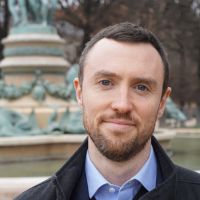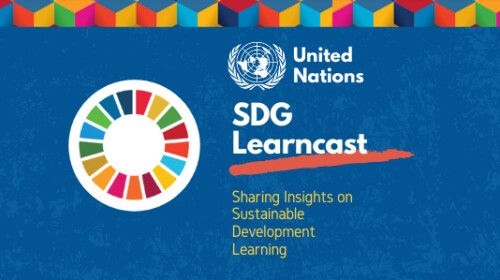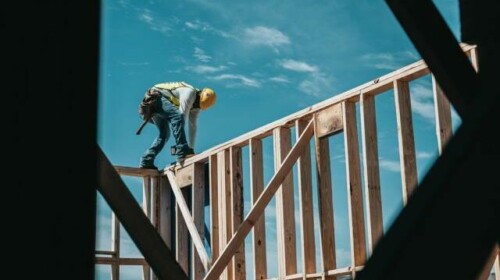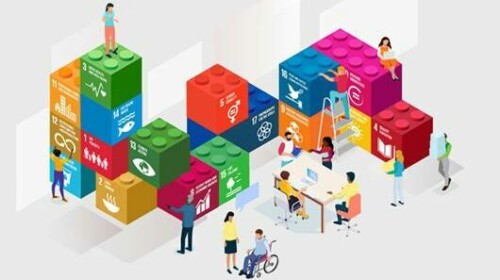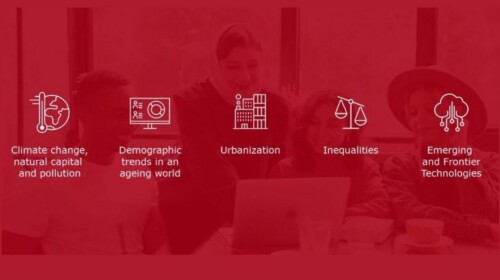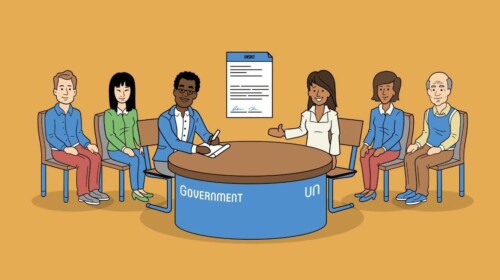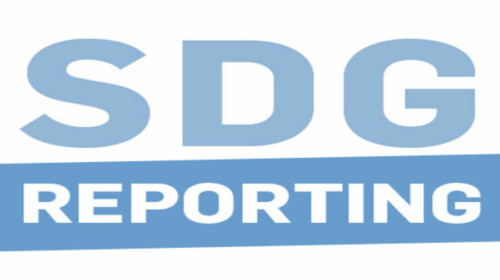In this episode, Guillaume Lafortune, Vice President of the Sustainable Development Solutions Network (SDSN), discusses the critical theme of long-term financing for sustainable development and the need for reform in the global financial architecture. He highlights the challenges hindering the progress of the Sustainable Development Goals (SDGs) and the estimated financing gap for the SDGs.
Guillaume emphasizes the importance of investing in energy and water for high returns and the systemic financial difficulties impacting developing countries. He also discusses the role of multilateral development banks and the need for a long-term affordable financing system. Guillaume concludes by highlighting the opportunities for reforming the global financial architecture.
[What follows is a transcription of the podcast, modified for enhanced web readability.]
Paulyn Duman: Welcome to the SDG Learncast with me, Paulyn Duman. In every episode, I bring insightful conversations around the subject of sustainable development and learning, helping us all to achieve a sustainable future.
As the world faces unparalleled challenges, including climate change, extreme inequality, and geopolitical shifts, the outdated financial system is struggling to meet these challenges. In this episode, we will explore the critical theme of long-term financing for sustainable development and the pressing need for reform in the global financial architecture. Our guest for this episode is Mr. Guillaume Lafortune, the Vice President of the Sustainable Development Solutions Network or SDSN.
Welcome to the SDG Learncast, Guillaume.
Guillaume Lafortune: Thank you so much. Great to be with you, Paulyn.
Paulyn Duman: Thank you so much, Guillaume. let's go straight to the topic on financing the SDGs. So in the report you published last year you highlighted that the progress of the SDGs has been slowing. How is the outdated financing system contributing to these challenges?
Guillaume Lafortune: There are 2 reports that are important here. There is indeed this paper that we published, and I was a coauthor to this; the lead author was our president, Professor Jeffrey Sachs, on the sidelines of an important Summit, which was hosted in Paris last June.
The paper is called "The Case for Long-Term Financing for the SDGs." Before diving into this, it's important to look at another SDSN report, the Sustainable Development Report, which tracks the progress that the global community is making towards achieving the goals. We also released our latest edition last June, and the bottom line is that we're not on track to achieving those 17 sustainable development goals. If we take the report of the UN, they say there's only 15 percent of all the targets that it could assess that are on track to be achieved.
We have a different methodology than the UN report. We arrived at the same conclusion, but our report was insisting on one thing, which is that by 2030, the gap in sustainable development, if we extrapolate the trends in the future, the gap between the poorest countries in the world and the richest country in the world in sustainable development might be larger than it was when we started this agenda in 2015, which, of course, Paulyn, as you would imagine, this was not the objective initially. And of course, COVID-19, conflicts in Ukraine, the Middle East, and other parts of the world had very negative impacts on the SDGs, but we were also not on track anyway before those multiple and simultaneous crises hit. And so at the SDSN, we try to be quite vocal these days on what might be the solutions and ways to double down efforts to reverse this trend.
I was just hearing someone talking about those SDGs becoming the slowly dying goals, which would be a pity because they remain the future we want. So, the way we're looking at it at SDSN is there are probably 5 things that are crucial to make progress on the SDGs. First is for countries to prepare long-term planning and pathways to achieve the goal. Second, it's to finance those pathways and those plans. Third is to promote global cooperation and partnerships for those goals.
Fourth is support for environmental sustainability, but also social inclusion. Fifth would be regular reporting and monitoring of the progress and performance. Let me underline the importance of the financing issue, essentially in the developing world; this is the major barrier to making any progress on this agenda.
Paulyn Duman: One of the things that I highlighted on the report that you published last year this really caught my eye, is that sustainable development is high return activity, and government should leverage borrowing to finance infrastructure and human capital investments because the resulting economic growth will compensate the borrowing costs over time. Investing in energy and water can provide high return activities. We need to convince governments across countries, across the world that this is important. It is a significant investment, but it is not impossible.
Guillaume Lafortune: Yeah. Absolutely, Paulyn.
This is a very important point, which is that what the SDGs are is a long-term investment plan into essentially two things. It's physical infrastructure, renewable energy, digital technologies, and human capital (health, education, social protection). Those are investments that take years to materialize. The actual physical infrastructure can take 4 or 5, even more, to build. And the returns on things like education are something that can take 10, 15, or 20 years from the moment a child manages to complete all compulsory education and possibly even tertiary education, acquiring skills that can actually innovate and bring value to the economy. These are long-term investments that will eventually lead to economic returns.
That's something I think is one of the issues with the way we currently assess risks or potential returns, including, for instance, in the credit risk rating system, which often focuses very much on short-term risks but less on the long-term growth potential for investing in the SDGs. In principle, if done correctly, this will increase the growth potential and, therefore, the capacity of a country to reimburse the principal and interests on loans, resulting in lower borrowing costs. So, how do we move from focusing on short-term risks to focusing on more long-term potential? According to a UN DESA report in 2022, financial markets overemphasize short-term economic returns and underweight longer-term issues, including environmental and social risks, as well as investments in resilience and sustainability.
It's this long-term perspective that we need to bring also to the financial market.
Paulyn Duman: That sounds very logical to me and sounds very clear. Anyone who would hear that we should invest in physical infrastructure and human capital, no one would go against investment in health and education. But I think the problem is really the global financial architecture, there are financing difficulties, and these are affecting the developing countries' efforts towards achieving sustainable development. Maybe you can give us examples of these systemic financial difficulties that impact developing countries and shed some light on this topic.
Guillaume Lafortune: Maybe first, we can just say a bit about what we mean by this global financial architecture. This is the complex system of public and private finance that channels world savings to world investments.
The Global Financial Architecture or the GFA includes multilateral institutions. For instance, the IMF and the World Bank, which, of course, can play a major role here, but also national and local budgets, public borrowing including tapping into capital markets, but also private equity and debt financing. So it's a very complex system essentially, of both public and private finance that can be channeled to achieve the sustainable development goals. There's a financing gap, and this is about 4 trillion. I think it's interesting to note that the UN Secretary-General last year called for an SDG stimulus to get closer to reducing this financing gap to achieve the SDGs. An interesting point that the UN Secretary-General is making is to call for an increase in the role of the multilateral development banks. By multilateral Development Banks, we're talking about the World Bank, the Asian Development Bank, the African Development Bank, the Inter-American Development Bank, the EBRD, the Islamic Development Bank. Those are institutions that can borrow at lower rates compared with their national countries because the loans are guaranteed by a larger range of countries, but are also equipped internally to align investments with the SDGs, and sometimes manage regional types of investments. In the case of the SDGs, it's not only national investments but also regional investments in terms of energy and other types.
So, multilateral development banks are very important. The UN Secretary-General called for an SDG stimulus of about an additional 500 billion per year. If we look right now at the main disbursements in 2021 of the World Bank, the Asian Development Bank, African Development Bank, Inter-American Development Bank, Asian Infrastructure Investment Bank, EBRD, and the Islamic Development Bank, we are at about a hundred billion per year. So there's a 4 trillion overall gap on the SDGs, and we have this SDG stimulus to mobilize at least an extra 500 billion. The multilateral development banks are operating at about a hundred billion a year. A final note on this, this paper was issued just before the summit in Paris on financing a global path for people and planet. What made the headlines after the summit was that there was this commitment to increase the lending capacities of multilateral development banks by 200 billion over 10 years.
So when people look at this figure, it's a large number. However, you always need to annualize those numbers. If you annualize this number after Paris, this is 20 billion. The SDG stimulus was calling for 500 billion. The SDG gap is 4 trillion. So the order of magnitude here is not there.
Paulyn Duman: You highlighted not just the policy signal but also the leadership. You also mentioned the important role of the multilateral development banks in addressing the financial challenges. I'm from a developing country, the Philippines, so it's more of an LMIC, a lower-middle-income country. In fact, what I see with the multilateral development banks is as the lender of last resort for developing countries.
But I think the problem is that they have limited financial firepower and usually intervene when it's already at an emergency level. There is a problem with the role to perform as the lender of last resort. Maybe you can unpack a bit more about the important role of the multilateral development bank in addressing the financial challenges for the SDGs in developing countries.
Guillaume Lafortune: There are at least three good reasons why the rich world should care about strengthening the global financial architecture. One is pure solidarity, and for me, that's already something that would be enough. But it's not only solidarity. The second reason is that if we let things go, CO2 emissions do not get addressed, global warming gets worse, and there continues to be deforestation and social unrest. Eventually, the rich world will be impacted. We can already see it with the increase in wildfires, but also the impact of population displacements. So, it's not as if what's going on in the rest of the world is isolated from the rich world. The third point, which we already discussed previously, is that I believe there are long-term economic returns, actually huge returns, from investing in long-term development. So, I think it's profitable, actually, in the long run for many actors.
I think there's a group of countries, just because you mentioned the Philippines, that are also impacted, in particular, by extreme events and the actual impact from climate change. The whole discussion around how to deal with the rising cost of adaptation, but also loss and damage is a very important one, especially for this group of countries, which are called the small island developing states. So, I think there was some progress that was done at the last few COPs around creating a fund for loss and damage, in particular. Now, again, to the numbers, right now, it's around 4 million USD that are available in this loss and damage fund that was announced at the COP in Dubai last year. This is just a fund that was just announced, so hopefully, countries will continue to chip in. But this is barely enough to actually just finance the secretariat that will coordinate this fund. So here also it's a question of magnitude, and this issue is an issue of justice as well. Many of those countries have no responsibility for climate change. They represent a very limited share of world greenhouse gas emissions if we look at the past 50 or even hundred years. Yet, they pay the hard price for those emissions.
Paulyn Duman: How can we make it affordable? How can we create a long-term affordable financing system for developing countries?
Guillaume Lafortune: So, the SDGs are an investment agenda. If we look at the current numbers, the average investment per person in a low-income country is about $175 per person compared with more than $11,000 per person in a high-income country. This is simply not enough to achieve SDGs. So, in my mind, there are five complementary strategies that are absolutely crucial in this whole debate around the global financial architecture.
First is to increase the scale of financing from official sources, including bilateral official development assistance.
The second is to increase the scale and the performance of national development banks that are fit for the purpose of achieving the SDGs.
The third, and we're reaching this point where we realize that there are a number of global commons that truly need global financing mechanisms. By global financing mechanisms, I mean global taxation, possibly on CO2 emissions, air and sea travel, financial transactions, and others.
The fourth is to reform the private capital markets and the regulation. There are a number of regulations in the pipeline so that we align the private sector with the achievement of the SDGs, and we increase the incentives to do so. But here, I would also include the reform of the credit risk system, a better recognition or assessment of the efforts that countries are making to implement the sustainable development goals.
And the fifth one is also to strengthen domestic resource mobilization, fight corruption, strengthen reform governance, also digital government, digital technology, and capacity building for more effective tax collection processes.
So those five priorities, in the context of the strengthening of the global financial architecture, are some of the big headline priorities that hopefully see progress.
There are a number of important summits coming up starting next September with the summit of the future in New York. Overall, we have a two-year opportunity, with the summit in New York, but also within 2025, the conference on financing for development, and also COP 30, which will be hosted by Brazil.
Paulyn Duman: I'm sure that our listeners would like to learn more about the work that you do. Maybe you can lead them to resources where they can find more about your studies and publications around this topic.
Guillaume Lafortune: Absolutely, Paulyn. Everything here is building on collective work at the SDSN, at the secretariat, but also within our networks, and of course, builds on the guidance of our president, Professor Jeff Sachs. You can find all our work at unsdsn.org, but also on our platform that we launched last June on the sidelines of this summit on financing in Paris, the SDG Transformation Center (sdgtransformationcenter.org). So you can find all of our tools for monitoring financing, also the SDGs.
Paulyn Duman: Guillaume, thank you so much.
Guillaume Lafortune: Thank you, Paulyn. It's a pleasure.
Takeaways
- The progress of the SDGs has been lacking or slowing, and there is a significant financing gap for the SDGs.
- Investing in energy and water can provide high returns and contribute to sustainable development.
- Systemic financial difficulties impacting developing countries' efforts towards achieving the SDGs.
- Reforming the global financial architecture is crucial, and there are opportunities to make significant progress.

